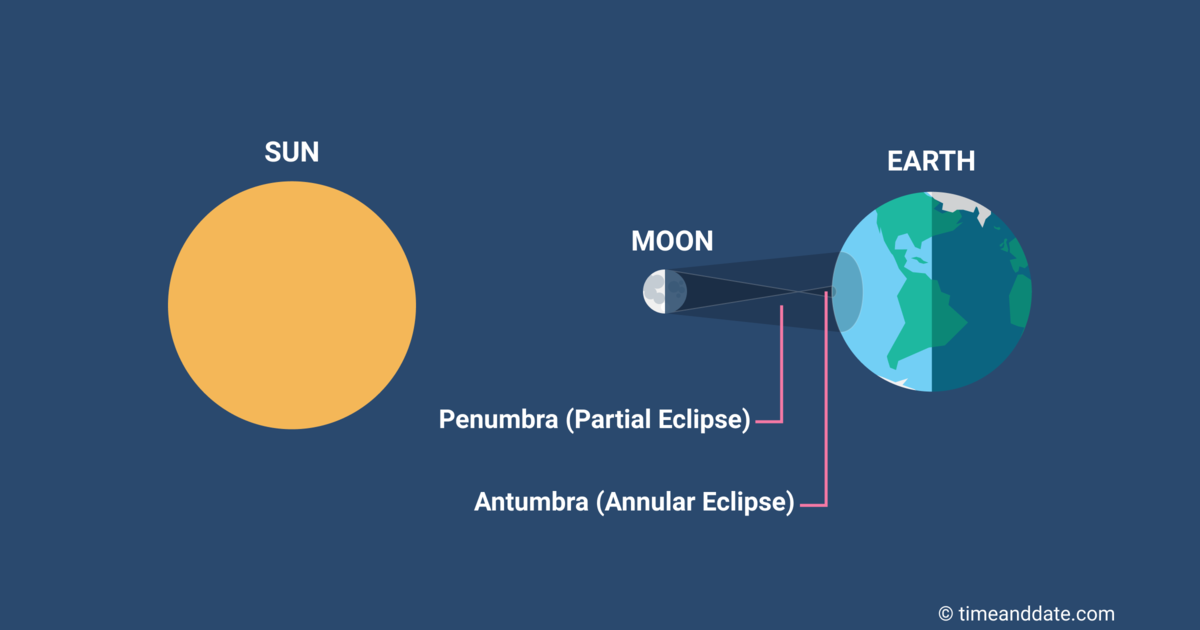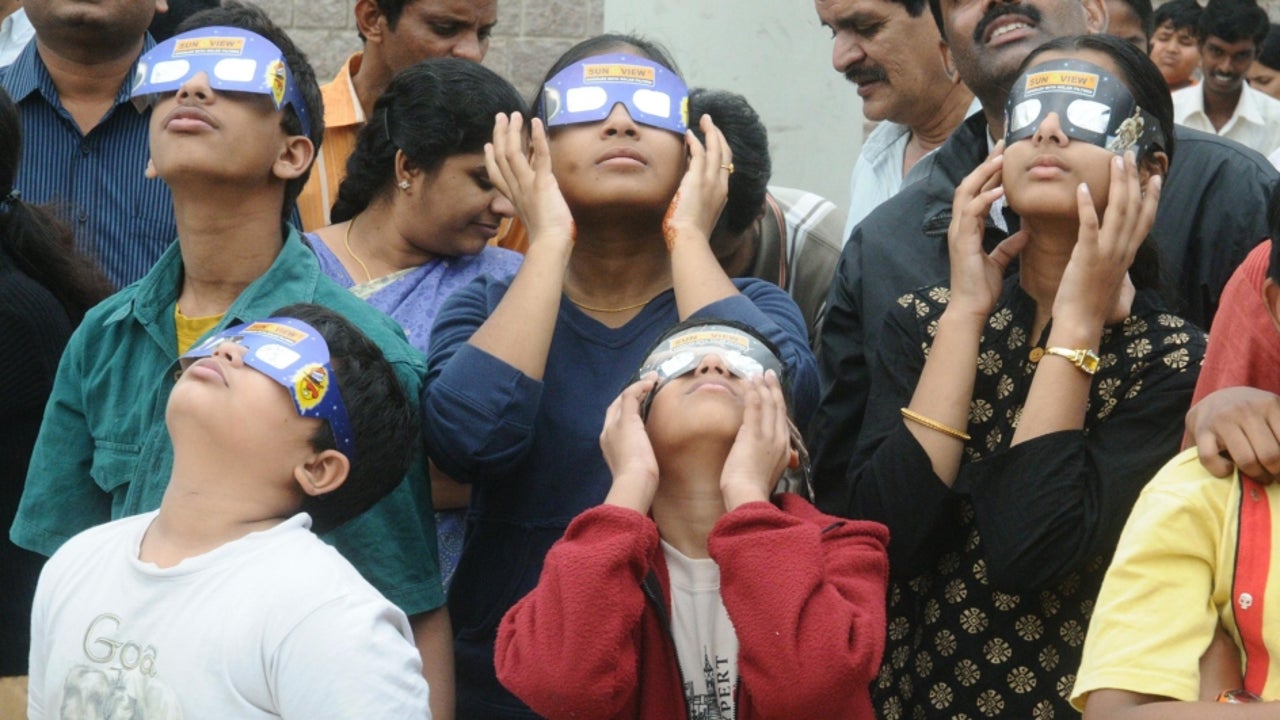On June 10, today, observers from certain parts of the globe will have an opportunity to witness an annular solar eclipse. Read on to find out if the eclipse is visible from your location and obtain tips about the way to observe it.
So, why does the solar eclipse happen? What varieties of eclipses are there?
Even though the sun is about 400 times larger than the moon, it also happens to be 400 times further far away from the Earth than the moon. For this reason, the sun and therefore the moon appear to possess virtually an equivalent angular size in our skies. Call it a coincidence or a mathematical beauty of nature, we can observe this spectacular phenomenon – the Solar Eclipse.

Annular Solar Eclipse (Image Credit: Time and Date)
An eclipse happens when the Moon comes in between a planet and the Sun, and fully or partially blocks the sunlight from reaching the earth. This spectacular astronomical event can occur only during the new phase of the moon.
If the Moon’s orbit were within the same plane as the Earth’s, we might observe solar eclipses each month. However, the lunar orbit is tilted at over 5 degrees to the Earth’s orbit around the Sun. For this reason, the earth becomes engulfed within the Moon’s shadow only at certain periods. Each year, solar eclipses can occur from 2 up to 5 times.
During an eclipse, the moon casts two shadows onto the earth one the umbra and penumbra. Counting on the sort of shadow you’re standing in you will see different types of solar eclipses. There are 4 sorts of solar eclipses: Total, partial, annular, and hybrid.
A total eclipse is that the most spectacular one. It occurs when the moon completely covers the sun’s disk. You’ll see a total eclipse as long as you’re standing within the umbral shadow of the moon. Because the umbra moves across the world, it creates a trail called the trail of totality. If your area is found within the trail of totality, you will be ready to experience a total eclipse.
If you’re standing within the penumbral shadow, outside the trail of totality, you will see a partial eclipse – The second type. The partial eclipse occurs when the moon covers only the part of the sun’s disk.
The third type is an annular eclipse. It happens when the moon passes directly ahead of the sun but is positioned too distant from the world in its orbit to hide the Sun completely.
Our natural satellite blocks out only the middle of the Sun’s disk, leaving its fringes visible. This produces a glowing ring — also referred to as annulus — around the Moon’s silhouette. So it’s called the “ring of fire” eclipse. It can last from but a second to over 12 minutes.
The fourth type may be a hybrid eclipse a mixture of two sorts of eclipses, counting on the observer’s location, a hybrid eclipse will appear as if a solar eclipse or a complete eclipse.
What time will the eclipse occur?

Image Credit: Time and Date
The first of the two eclipses in 2021 is going to be an annular solar eclipse. It occurs on June 10 and can be visible from parts of Canada, Greenland, and Russia. At different locations, the eclipses are going to be visible at different times:
- In Canada, the solar eclipse is going to be visible from 09:55 to 10:47 GMT within the towns located in Ontario, Nunavut, and Quebec — Nipigon, Pickle Lake, Sanikiluaq, Inukjuak, Salluit, and other towns.
- In Greenland, the solar eclipses are going to be visible from 10:32 to 10:41 GMT in Qaanaaq, Savissivik, and on Thule Air Base.
- In Russia, the solar eclipse is going to be visible from 11:22 to 11:29 GMT within the towns located in Sakha (Yakutia) — Chokurdakh, Srednekolymsk, Belaya Gora, and Zyryanka.
If you don’t live in any of those three regions, don’t get upset. People located in North America, Europe, and Northern Asia will have an opportunity to ascertain a partial eclipse.
It won’t be as breathtaking because of the annular one, but it’ll still be worth watching. Here are some cities where partial eclipses are going to be visible: New York, Montréal, Toronto, Washington DC, London, Reykjavik, Anadyr, Yakutsk, and Ulaanbaatar.
In India, too, the eclipses are going to be partial. Moreover, it’ll only be visible from the northern-northeastern extremes of the country from Ladakh and Arunachal Pradesh for a couple of minutes before sunset.
Safety Notes:
Don’t forget that you simply must not look directly at the Sun. While observing an eclipse, use proper eye protection that blocks the harmful part of the Sun’s radiation.

Watching Solar Eclipse with safety measures (Image Credit: The Weather Channel)
Using a proper, authorized Solar Filter to witness the event is an absolute must. If a filter isn’t available, the simplest also because the cheapest thanks to seeing the annular eclipse are to use a plane mirror to project the Sun on a screen or a wall.
When is the next solar eclipse?
As we’ve already mentioned, there’ll be only two solar eclipses in 2021. The other will occur on December 4 and it’ll be a total eclipse. Unfortunately, the entire phases are going to be visible only from Antarctica; in many other regions, observers will see only a partial eclipse.
Thanks for reading this text. Hope it’s useful, isn’t it? Let us know within the comments section below. We wish you successful observations!
Suggested Reading: May 26th Lunar Eclipse: Everything You Need To Know
Author